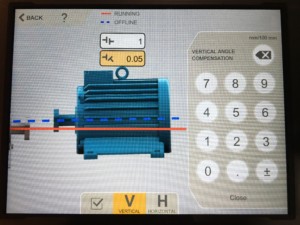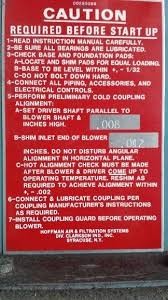Understanding & Compensating for Thermal Growth
 A major asset is being installed, and the asset is vital to the success of a brand new, high-profit product being introduced to the site. This product is enough to keep the site operational for many years to come. The installation of the asset is critical, and there is extensive prep work to eliminate soft foot, ensuring the base is flat (using geometric measurement) and that the asset is aligned properly.
A major asset is being installed, and the asset is vital to the success of a brand new, high-profit product being introduced to the site. This product is enough to keep the site operational for many years to come. The installation of the asset is critical, and there is extensive prep work to eliminate soft foot, ensuring the base is flat (using geometric measurement) and that the asset is aligned properly.
Shortly after the installation is complete, the asset is started up to test and commission. Initially, the asset runs with no issues, no vibration and minimal heat at the coupling and bearings. However, after a few minutes, vibrations and can be detected, the coupling and bearings are heating up and the current draw increases. The asset is immediately shut down, and the team begins to check the alignment, maybe a bolt wasn’t torqued, and the asset comes out of alignment.
After setting up the Easy-Laser alignment tool, the alignment is confirmed as good. A few more checks and the asset is started up again. The same thing happens, it runs good for a minute or two, but then begins to display signs of severe misalignment. What is happening? After a careful review of the Millwright Manual, Thermal Growth comes up a few times. What is this thermal growth and how can it impact alignment? The installation team decides they need to learn more about Thermal Growth before they can try to start the asset again.
What is Thermal Growth
Thermal growth occurs when the thermal expansion in the driven and driving assets are not equal. As components heat up, they expand and depending on the material they are made of; they expand at different rates. The expansion rate of the metals can be calculated, or they may be provided the manufacturer. When the asset is subjected to thermal growth, misalignment will occur.
Determining How Much to Compensate
Not all machinery needs to take Thermal Growth into consideration. The machinery that does need to take Thermal Growth into should look for specifications from the OEM. Typically, the OEM provides the alignment offsets that are required during a cold alignment so that during operation, the machinery comes into alignment (see tag). If the OEM does not provide the offsets, it can be calculated.
The Thermal Growth Formula is TG= T x L x C; where TG is the amount of growth or offset that must be compensated for;
- T is the change in temperature of the machine in Fahrenheit;
- L is the distance in mm, from the shim plan to the shaft centerline;
-
C is the coefficient of linear expansion. The coefficient depends upon the material that the machine consists of;
- Aluminum – 0.0000126
- Bronze – 0.0000101
- Cast Iron – 0.0000059
- Copper – 0.0000092
- Carbon Steel – 0.0000063
- Stainless Steel – 0.0000074
A calculation for Thermal Growth would look something like this;
-
The cast iron asset has a base to bearing centerline distance of 12″ and will heat up to 100 F when at full load. Based on these factors, what is the amount of thermal growth that must be compensated for?
- TG = T x L x C
- TG = 100 x 12 x 0.0000059
- TG = 1200 x 0.0000059
- TG = 0.007″
Unequal Thermal Growth in Assets
In some circumstances, the asset will experience thermal growth in unequal amounts. Think of a large motor with a cooling fan at one end. The end with the cooling fan will be much cooler and experience less thermal growth. This adds additional complexity to calculating thermal growth, but it is not impossible.
In this case, each plane will need to have the thermal growth plotted and the actual offset will be able to be determined. For more information on how to calculate and compensate for unequal thermal growth, please see the following articles by Benchmark PDM:
- Understanding Thermal Growth in Your Rotating Machinery – Part 2
- Understanding Thermal Growth in Your Rotating Machinery – Part 3
When presented with unequal thermal growth, it is much easier and more accurate to use the information provided by the OEM, but it is not always available. This is why it is important to understand how to do it manually when required.
Compensating for Thermal Growth
With an understanding of Thermal Growth and how much the asset will grow, the installation team can then take the necessary actions to ensure proper alignment at running temperature. Depending on if the Thermal Growth is equal or unequal, there may be slightly different approaches;
- Equal Thermal Growth can be compensated by offsetting the alignment by the amount of the thermal growth. This may mean raising the driver or driven unit. If you are using an Easy-Laser tool, you can put the offset into the tool and perform alignment as usual. If using dial indicators, you would have to zero the dial indicator off by the amount of Thermal Growth calculated.
- Unequal Thermal Growth is a bit more difficult to compensate for. In addition to offsetting the alignment by the amount of thermal growth, the angle must be entered into the Easy-Laser tool (usually in thous/in). Arriving at the angle requires a bit of calculation or plotting as discussed in the Benchmark PDM articles, but it can be accomplished by determining the difference between the front and back of the asset and dividing it by the number of inches to arrive at the angle of thous/inch.
Results!
After learning about Thermal Growth, the installation team reviews the asset in detail and finds a tag indicating that the alignment must be compensated for thermal growth by;
- Setting the driver shaft 0.008″ higher than the driven shaft
- Shim the inlet end of the asset 0.012.”
The value is plugged into their Easy-Laser alignment tool and the alignment is completed. The asset is started up and tested without issue.
Does your organization have an alignment procedure in which all aspects of alignment are considered? Forgetting about thermal growth or not being aware of it has cost unmeasurable amounts of downtime. Make sure to develop an alignment procedure that addresses all aspects of alignment to ensure long, trouble free asset life. If you are looking for assistance in developing a robust alignment program through expert training, or are looking for quality laser alignment equipment such as the award winning Easy Laser XT440, please contact [email protected], or visit our store.
Remember, to find success; you must first solve the problem, then achieve the implementation of the solution, and finally sustain winning results.
I’m James Kovacevic
Eruditio, LLC
Where Education Meets Application
Follow @EruditioLLC
References;
